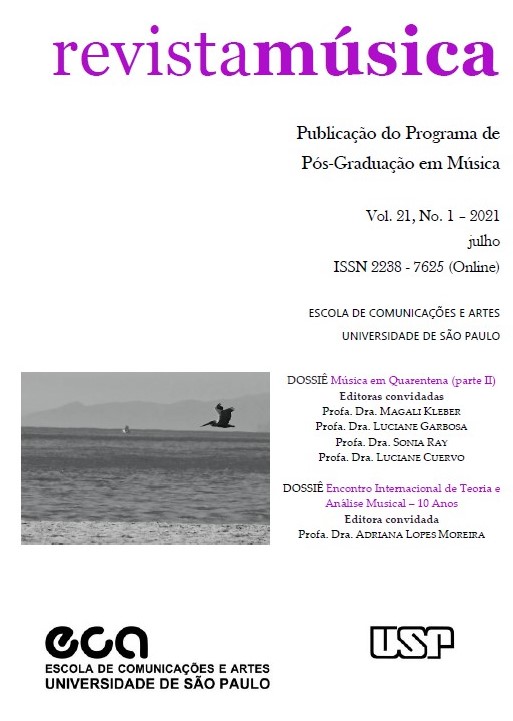An Analysis of the 4th Movement of György Ligeti’s Musica Ricercata based on Information Theory and Number Partitioning
DOI:
https://doi.org/10.11606/rm.v21i1.188845Palabras clave:
György Ligeti, Musica ricercata, Information theory, Music analysis, Number partitioningResumen
In this paper we present a mathematically oriented analysis of the 4th Movement of György Ligeti’s Musica Ricercata (MR). The pitch analysis is based on Theory of Information and rhythm is analyzed through the Theory of Partitions of integer numbers. After a brief historical review of Musica Ricercata and its structure we make an analysis of the pitch distribution along the whole MR4 score, as well the Left and Right hand separately, through Theory of Information. We calculate two Information measures, namely, the Shannon’s Entropy and the Kullback-Leibler Divergence for the three cases. In the second part, about rhythm, we introduce a simple notation for coding rhythm patterns in terms of partitions of an integer number. We show that, with few exceptions, Ligeti used the partitions of number 6 to get rhythm variations on the Right hand against the ostinato on the Left one. In addition, we show the usefulness of the so called Hasse Diagram as a pre-compositional device to generate rhythm patterns.
Descargas
Referencias
ANDREWS, George. The Theory of Partitions. Massachusetts: Addison-Wesley Pub. Co., 1976.
CAPUZZO, Helder D. Musica Ricercata de György Ligeti: considerações de performance. Dissertação (Mestrado em Música) – Escola de Comunicações e Artes, Universidade de São Paulo, São Paulo, 2015.
COVER, Thomas M.; THOMAS, Joy A. Elements of Information Theory. 2nd Edition. New Jersey: John Wiley & Sons Inc., 2006.
GENTIL-NUNES, Pauxy. Análise particional: uma mediação entre Composição Musical e a Teoria das Partições. Tese (Doutorado em Música) – Universidade Federal do Rio de Janeiro, Centro de Letras e Artes, Rio de Janeiro, 2009.
GENTIL-NUNES, Pauxy. Análise particional: uma mediação entre Composição Musical e a Teoria das Partições. In: SIMPÓSIO DE COGNIÇÃO E ARTES MUSICAIS, SINCAM, 6., 2010, Rio de Janeiro. Anais... Rio de Janeiro, Universidade Federal do Rio de Janeiro, Escola de Música, 2010, p. 343-354. Available at: https://abcogmus.org/wp-content/uploads/2020/09/SIMCAM6.pdf. Accessed: 25 April 2019.
GENTIL-NUNES, Pauxy. PARSEMAT: uma ferramenta para a Análise Particional. In: SIMPÓSIO DE COGNIÇÃO E ARTES MUSICAIS, SINCAM, 6., 2010, Rio de Janeiro. Anais... Rio de Janeiro, Universidade Federal do Rio de Janeiro, Escola de Música, 2010, p. 355-357. Available at: https://abcogmus.org/wp-content/uploads/2020/09/SIMCAM6.pdf. Accessed: 25 April 2019.
GRANTHAM, Daniel. Ligeti’s Early Experiments in Compositional Process: Simple Structures in “Musica Ricercata”. Thesis (Master of Music) – University of North Texas, Denton, Texas, 2014.
GRIFFITHS, Paul. György Ligeti: Central-European Composer of Bleakness and Humor, Dies at 83. New York Times, [s.n.], 13 June 2006. Available at: https://www.nytimes.com/2006/06/13/arts/music/13ligeti.html . Accessed: 30 April 2021.
HARRIS, Zellig. A Theory of Language and Information: A Mathematical Approach. New York: Oxford University Press, 1991.
KEREFKY, Márton. “A ‘New Music’ from Nothing”: György Ligeti's Musica Ricercata. Studia Musicologica, v. 49, n. 3/4, p. 203-230, 2008.
KNOPOFF, Leon; Hutchinson, William. Information Theory for Musical Continua. Journal of Music Theory, v. 25, n. 1, p. 17- 44, 1981.
LEVY, Benjamin. Metamorphosis in Music: The Compositions of György Ligeti in the 1950s and 1960s. New York: Oxford University Press, 2017.
LIGETI, György. Musica Ricercata per Pianoforte (1951-1953). Mainz: Schott, 1995. 1 score.
MAIA, Adolfo. Clapping Music: Complexity and Information in Reich's Rhythm Space. Perspective of New Music, v. 58, n. 1, p. 91-121, 2020.
MAIA, Igor; MAIA Jr., Adolfo. A Number Partitioning Approach to Rhythm and its Application to Analysis of Ligeti’s Musica Ricercata 4. In: ENCONTRO INTERNACIONAL DE TEORIA E ANÁLISE MUSICAL, 5., 2019, Campinas. Anais... Campinas, Universidade Estadual de Campinas, 2019, p. 209-218. Available at: https://eitam5.nics.unicamp.br/wp-content/uploads/2020/12/EITAM5-paper_15_MaiaI_MaiaA-pp_209-218.pdf. Accessed: 30 April 2021.
MARSHALL, Kimberly. György Ligeti (1923-2006). In: ANDERSON, Christopher S. (Ed.). Twentieth-Century Organ Music. New York and London: Routledge, Taylor & Francis Group, 2012.
PIERCE, John R. An Introduction to Information Theory: Symbols, Signals and Noise. 2nd Edition. New York: Dover Publications Inc., 1980.
SHANNON, Claude. A Mathematical Theory of Communication. The Bell System Technical Journal, v. 27, p. 379-423, 623-656, 1948.
STEINITZ, Richard. György Ligeti: Music of Imagination. Boston: Northeastern University Press, 2003.
TEMPERLEY, David. Music and Probability. Cambridge, MA: The MIT Press, 2007.
TOOP, Richard. György Ligeti. London: Phaidon Press Limited, 1999.
TUCKER, Zoë. Emergence and Complexity in Music. Thesis (Bachelor of Science) – Harvey Mudd College, Department of Mathematics, 2017. Available at: https://scholarship.claremont.edu/hmc_theses/101. Accessed: 30 April 2021.
ZHAO, Yufei. Young Tableaux and the Representations of the Symmetric Group. The Harvard College Mathematics Review, v. 2, p. 33-45, 2008.
Descargas
Publicado
Número
Sección
Licencia
Derechos de autor 2021 Adolfo Maia Jr., Igor Leão Maia

Esta obra está bajo una licencia internacional Creative Commons Atribución-NoComercial-CompartirIgual 4.0.
Autores que publicam nesta revista concordam com os seguintes termos:
- Autores mantém os direitos autorais e concedem à revista o direito de primeira publicação, com o trabalho simultaneamente licenciado sob a CC Attribution-NonCommercial-ShareAlike 4.0 que permite o compartilhamento do trabalho com reconhecimento da autoria e publicação inicial nesta revista.
- Autores têm autorização para assumir contratos adicionais separadamente, para distribuição não-exclusiva da versão do trabalho publicada nesta revista (ex.: publicar em repositório institucional ou como capítulo de livro), com reconhecimento de autoria e publicação inicial nesta revista.
- Autores têm permissão e são estimulados a publicar e distribuir seu trabalho online (ex.: em repositórios institucionais ou na sua página pessoal) a qualquer ponto antes ou durante o processo editorial, já que isso pode gerar alterações produtivas, bem como aumentar o impacto e a citação do trabalho publicado (Veja O Efeito do Acesso Livre).


